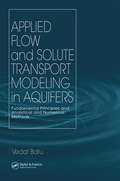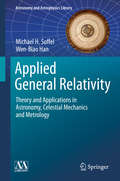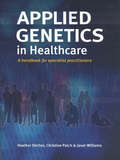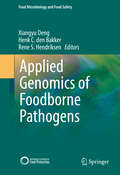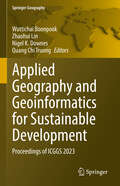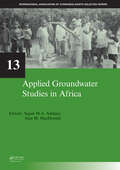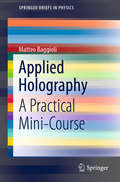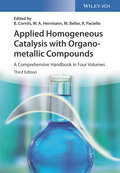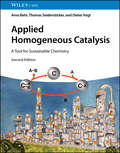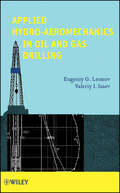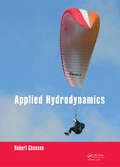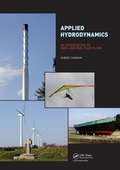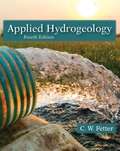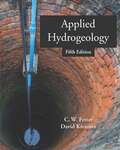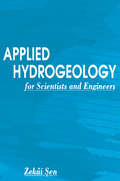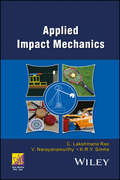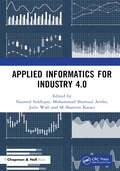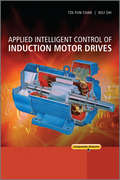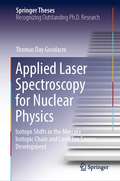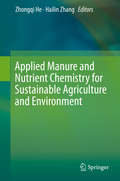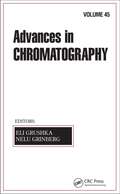- Table View
- List View
Applied Flow and Solute Transport Modeling in Aquifers: Fundamental Principles and Analytical and Numerical Methods
by Vedat BatuOver recent years, important contributions on the topic of solving various aquifer problems have been presented in numerous papers and reports. The scattered and wide-ranging nature of this information has made finding solutions and best practices difficult. Comprehensive and self-contained, Applied Flow and Solute Transport Modeling in Aquifers co
Applied Frequency-Domain Electromagnetics
by Robert PaknysUnderstanding electromagnetic wave theory is pivotal in the design of antennas, microwave circuits, radars, and imaging systems. Researchers behind technology advances in these and other areas need to understand both the classical theory of electromagnetics as well as modern and emerging techniques of solving Maxwell's equations. To this end, the book provides a graduate-level treatment of selected analytical and computational methods. The analytical methods include the separation of variables, perturbation theory, Green's functions, geometrical optics, the geometrical theory of diffraction, physical optics, and the physical theory of diffraction. The numerical techniques include mode matching, the method of moments, and the finite element method. The analytical methods provide physical insights that are valuable in the design process and the invention of new devices. The numerical methods are more capable of treating general and complex structures. Together, they form a basis for modern electromagnetic design. The level of presentation allows the reader to immediately begin applying the methods to some problems of moderate complexity. It also provides explanations of the underlying theories so that their capabilities and limitations can be understood.
Applied Gas Dynamics
by Ethirajan RathakrishnanA revised edition to applied gas dynamics with exclusive coverage on jets and additional sets of problems and examples The revised and updated second edition of Applied Gas Dynamics offers an authoritative guide to the science of gas dynamics. Written by a noted expert on the topic, the text contains a comprehensive review of the topic; from a definition of the subject, to the three essential processes of this science: the isentropic process, shock and expansion process, and Fanno and Rayleigh flows. In this revised edition, there are additional worked examples that highlight many concepts, including moving shocks, and a section on critical Mach number is included that helps to illuminate the concept. The second edition also contains new exercise problems with the answers added. In addition, the information on ram jets is expanded with helpful worked examples. It explores the entire spectrum of the ram jet theory and includes a set of exercise problems to aid in the understanding of the theory presented. This important text: Includes a wealth of new solved examples that describe the features involved in the design of gas dynamic devices Contains a chapter on jets; this is the first textbook material available on high-speed jets Offers comprehensive and simultaneous coverage of both the theory and application Includes additional information designed to help with an understanding of the material covered Written for graduate students and advanced undergraduates in aerospace engineering and mechanical engineering, Applied Gas Dynamics, Second Edition expands on the original edition to include not only the basic information on the science of gas dynamics but also contains information on high-speed jets.
Applied General Relativity: Theory and Applications in Astronomy, Celestial Mechanics and Metrology (Astronomy and Astrophysics Library)
by Michael H. Soffel Wen-Biao HanIn the late 20th and beginning 21st century high-precision astronomy, positioning and metrology strongly rely on general relativity. Supported by exercises and solutions this book offers graduate students and researchers entering those fields a self-contained and exhaustive but accessible treatment of applied general relativity. The book is written in a homogenous (graduate level textbook) style allowing the reader to understand the arguments step by step. It first introduces the mathematical and theoretical foundations of gravity theory and then concentrates on its general relativistic applications: clock rates, clock sychronization, establishment of time scales, astronomical references frames, relativistic astrometry, celestial mechanics and metrology. The authors present up-to-date relativistic models for applied techniques such as Satellite LASER Ranging (SLR), Lunar LASER Ranging (LLR), Globale Navigation Satellite Systems (GNSS), Very Large Baseline Interferometry (VLBI), radar measurements, gyroscopes and pulsar timing. A list of acronyms helps the reader keep an overview and a mathematical appendix provides required functions and terms.
Applied Genetics in Healthcare: A Handbook For Specialist Practitioners
by Janet Williams Heather Skirton Christine PatchIncreasingly, genomics is having an impact on mainstream healthcare. All health professionals will now be required to understand basic genetic concepts, but the depth of knowledge required will vary according to the role of the practitioner, and the setting in which he or she works. Following the success of Genetics for Healthcare Professionals by Skirton and Patch, which was written for practitioners at foundation level, Applied Genetics in Healthcare approaches the issues of genetic healthcare at a more advanced level and is primarily intended as a handbook for those training or working as genetic specialists. However, the book will also be a useful resource for practitioners who specialize in particular fields of healthcare that require knowledge of genetics in specific topics. Those experienced in genetic healthcare will find the book to be a valuable handbook and a source of references for wider reading. All of the authors have worked extensively in the field of genetic healthcare and have used their experience in both genetics nursing and genetics counseling to create a working handbook that is rooted in clinical practice.
Applied Genomics of Foodborne Pathogens (Food Microbiology and Food Safety)
by Xiangyu Deng Henk C. Bakker Rene S. HendriksenThis book provides a timely and thorough snapshot into the emerging and fast evolving area of applied genomics of foodborne pathogens. Driven by the drastic advance of whole genome shot gun sequencing (WGS) technologies, genomics applications are becoming increasingly valuable and even essential in studying, surveying and controlling foodborne microbial pathogens. The vast opportunities brought by this trend are often at odds with the lack of bioinformatics know-how among food safety and public health professionals, since such expertise is not part of a typical food microbiology curriculum and skill set. Further complicating the challenge is the large and ever evolving body of bioinformatics tools that can obfuscate newcomers to this area. Although reviews, tutorials and books are not in short supply in the fields of bioinformatics and genomics, until now there has not been a comprehensive and customized source of information designed for and accessible to microbiologists interested in applying cutting-edge genomics in food safety and public health research. This book fills this void with a well-selected collection of topics, case studies, and bioinformatics tools contributed by experts at the forefront of foodborne pathogen genomics research.
Applied Geography and Geoinformatics for Sustainable Development: Proceedings of ICGGS 2022 (Springer Geography)
by Zhaohui Lin Parichat Wetchayont Wuttichai Boonpook Pakorn MeksangsouyThis volume presents the proceedings of the 2nd International Conference of Geography and Geoinformatics for Sustainable Development (ICGGS), held in Phuket, Thailand, April 7-8, 2022. The collection focuses on the importance of spatial thinking and planning by applying geography concepts and geospatial technology innovations in solving global problems such as environmental degradation, urban pollution, and climate change. The proceedings consist of case studies on wide-ranging spatial issues in developing countries, addressing challenges in mainstreaming sustainable development paradigms into their economies to improve natural resource and environmental management. One of the main goals of the volume is to share and exchange different points of view regarding global, regional, and local spatial issues and how to use geography and geoinformatics for building resilience in multiple sectors, e.g., water, ecosystems, agriculture, and health. It offers the opportunity to learn about how geospatial concepts and technologies can contribute to environmental sustainability, while advancing education and research related to geography and geoinformatics. It will be a useful resource for students and researchers to initiate research ideas related to geospatial topics in regional and local scales.
Applied Geography and Geoinformatics for Sustainable Development: Proceedings of ICGGS 2023 (Springer Geography)
by Zhaohui Lin Wuttichai Boonpook Nigel K. Downes Quang Chi TruongThis volume presents the proceedings of the 3rd International Conference of Geography and Geoinformatics for Sustainable Development (ICGGS), held in Can Tho, Vietnam, November 30 - December 2, 2023. It focuses on cutting-edge applications of geoinformatics for sustainable development, including using artificial intelligence and machine learning in environmental monitoring, integrating the Internet of Things (IoT) for real-time data collection, and advanced techniques in remote sensing for urban development and climate change adaptation. Additionally, this volume features case studies predominantly from Vietnam and Thailand, providing fresh insights into regional challenges and innovative solutions for sustainable resource management.
Applied Groundwater Studies in Africa: IAH Selected Papers on Hydrogeology, volume 13
by Alan MacDonald Segun AdelanaGroundwater is Africa‘s most precious natural resource, providing reliable water supplies for many people. Further development of groundwater resources is fundamental to increasing access to safe water across the continent to meet coverage targets and reduce poverty. There is also an increasing interest in the use of groundwater for irrigated
Applied Holography: A Practical Mini-Course (SpringerBriefs in Physics)
by Matteo BaggioliThis primer is a collection of notes based on lectures that were originally given at IIT Madras (India) and at IFT Madrid (Spain). It is a concise and pragmatic course on applied holography focusing on the basic analytic and numerical techniques involved. The presented lectures are not intended to provide all the fundamental theoretical background, which can be found in the available literature, but they concentrate on concrete applications of AdS/CFT to hydrodynamics, quantum chromodynamics and condensed matter. The idea is to accompany the reader step by step through the various benchmark examples with a classmate attitude, providing details for the computations and open-source numerical codes in Mathematica, and sharing simple tricks and warnings collected during the author’s research experience. At the end of this path, the reader will be in possess of all the fundamental skills and tools to learn by him/herself more advanced techniques and to produce independent and novel research in the field.
Applied Homogeneous Catalysis with Organometallic Compounds: A Comprehensive Handbook in Four Volumes
by Matthias Beller Boy Cornils Wolfgang A. Herrmann Rocco PacielloHomogeneous catalysis is the success story of organometallic chemistry. Since the discovery of hydroformylation by O. Roelen in 1938, catalytic applications have paved the way of organometallic compounds in industry. Bulk and fine chemicals, and even natural products are being produced via homogeneous organometallic catalysis. The enormous breadth of this topic in view of both basic research and industrial application is met in this three volume handbook edited jointly by W. A. Herrmann and B. Cornils. The list of contributors reads like a who-is-who in organometallic chemistry and homogeneous catalysis. In this handbook, experts will find the current state-of-the-art in their field and advanced students will benefit from the concise treatment of important catalytic reactions and processes. With its balanced presentation of the truly interdisciplinary topic and its outstanding editor- and authorship, the 'Cornils/Herrmann' is beyond common standards. Now in its second, completely revised and enlarged edition!
Applied Homogeneous Catalysis: A Tool for Sustainable Chemistry
by Arno Behr Thomas Seidensticker Dieter VogtOne-stop reference on homogeneous catalysis, from general concepts through detailed examples and industrial applications Accessible and richly illustrated, Applied Homogeneous Catalysis provides a concise overview of the broad field of homogeneous transition metal catalysis and its applications in the chemical industry. This newly revised and updated second edition puts special emphasis on green chemistry, sustainable resources, and processes. The book is divided into five parts. Part I presents the basics of transition metal catalysis. Part II focuses on process engineering aspects. Part III provides details of the most important catalytic reactions. Part IV describes catalytic conversions closely related to classical homogeneous transition metal catalysis, such as nano-, electro-, photo- and organocatalysis. Part V covers new feedstocks and other topics, concluding with an outlook on future challenges of homogeneous catalysis. The book contains numerous mechanistic details, technical information, and illustrative examples. The chapters are enlivened by various excursions that relate the content to everyday life or introduce important personalities. Didactically, the book is completed with learning objectives and take-home messages for each chapter, as well as more than 400 questions and answers for self-testing. Written by a team of internationally renowned experts in the field, with a wealth of experience in industry and teaching, Applied Homogeneous Catalysis includes information on: Economic importance of industrial homogeneously-catalyzed reactions and basics of organometallic chemistry, including types of bonds, elemental steps, and mechanisms Common approaches for separating the homogeneous catalyst from the products after the reaction and using combinatorial chemistry and high throughput screening to achieve optimal results Activating “inactive” molecules such as carbon dioxide and nitrogen, and harnessing homogeneous catalysis for feedstock diversification by recycling polymers or using renewables. Providing expansive coverage of the subject, Applied Homogeneous Catalysis is an essential guide for researchers and professionals in the pharmaceutical, polymer, and fine and bulk chemicals industries working on catalysis or entering the field, as well as for Master’s and PhD students in organic chemistry, chemical engineering, and related fields.
Applied Hydro-Aeromechanics in Oil and Gas Drilling
by Eugeniy G. Leonov Valeriy I. IsaevHydromechanical processes underlie the majority of technology operations in drilling, and present a crucial concern as the pace and depth of drilling increases in today's energy-hungry world. Applied Hydroaeromechanics in Oil and Gas Drilling offers a unique resource for properly modeling and understanding the hydrodynamic forces affecting a drilling site. Combining hydrodynamic theory with specific drilling applications, this coverage provides readers with a comprehensive reference for designing, planning, and optimizing drilling operations.
Applied Hydrodynamics: An Introduction
by Hubert ChansonThis textbook treats Hydro- and Fluid Dynamics, the engineering science dealing with forces and energies generated by fluids in motion, playing a vital role in everyday life. Practical examples include the flow motion in the kitchen sink, the exhaust fan above the stove, and the air conditioning system in our home. When driving a car, the air flow
Applied Hydrodynamics: An Introduction to Ideal and Real Fluid Flows
by Hubert ChansonFluid dynamics is the engineering science dealing with forces and energies generated by fluids in motion. Fluid dynamics and hydrodynamics play a vital role in everyday life. Practical examples include the flow motion in the kitchen sink, the exhaust fan above the stove, and the air conditioning system in our home. When driving a car, the air flow
Applied Hydrogeology
by C. W. FetterHydrogeology¿s importance has grown to become an integral part not only of geology curricula, but also those in environmental science and engineering. Applied Hydrogeology serves all these students, presenting the subject¿s fundamental concepts in addition to its importance in other disciplines. Fetter skillfully addresses both physical and chemical hydrogeology, highlighting problem solving throughout the book.Case studies, Excel-based projects, and working student versions of software used by groundwater professionals supplement the fourth edition¿s insightful explanations and succinct solutions to real-world challenges. Each chapter concludes with example problems, a notation of symbols, and informative analysis. A glossary of hydrogeological terms adds significant value to this comprehensive text. Fetter¿s accessible coverage prepares readers for success in their careers well beyond the classroom.
Applied Hydrogeology
by C. W. Fetter David KreamerThere is a continued demand for well-trained and competent hydrogeologists, especially in the environmental sector. For decades, Fetter's Applied Hydrogeology has helped prepare students to excel in careers in hydrogeology or other areas of environmental science and engineering where a strong background in hydrogeology is needed. The text's long-standing tradition as a vital resource is further enhanced in the fifth edition by Kreamer’s added expertise. <p><p>Stressing the application of mathematics to problem-solving, example problems throughout the book provide students the opportunity to gain a much deeper understanding of the material. Some important topics include the properties of aquifers, the principles of groundwater flow, water chemistry, water quality and contamination, and groundwater development and management. The addition of new case studies and end-of-chapter problems will strengthen understanding of the occurrence and movement of ground water in a variety of geological settings.
Applied Hydrogeology for Scientists and Engineers
by Zekai SenIn order to properly plan, design, and operate groundwater resources projects, it is necessary to measure - over time or distance - pertinent groundwater variables such as drawdown and discharge in the field. Applied Hydrogeology for Scientists and Engineers shows how to assess and interpret these data by subsurface geological setup and processing. The book helps readers estimate relevant groundwater parameters such as storativity, transmissivity, and leakage coefficient.The text addresses many interrelated disciplines such as geology, hydrology, hydrogeology, engineering, petroleum geology, and water engineering. Traditional and current models for application are presented. One of the unique features of the book is the inclusion of new and previously unpublished ideas, concepts, techniques, approaches, and procedures developed by the author. Among these are hydrogeophysical concepts, slope matching techniques, volumetric approach solution for complicated groundwater flows, non-Darcian flow law applications, aquifer sample functions, dimensionless-type straight line methods, non-linear flow-type curves, discharge calculations from early time-drawdown data, storage coefficient estimation procedure for quasi-steady state flow, and much more. The pitfalls in aquifer test analysis are also detailed. Fractured medium flow adds yet another dimension to the book. Each method is supplemented by actual field data applications from worldwide case studies.Applied Hydrogeology for Scientists and Engineers covers the topics of groundwater reservoirs, the evaluation of aquifer parameters, aquifer and flow properties, flow properties and bore hole tests, aquifer tests in porous and fractured media, well hydraulics, groundwater flow and aquifer tests, and field measurements and their interpretations.This new reference also works well as a post-graduate textbook on the subject. Applied Hydrogeology for Scientists and Engineers expands the reader's knowledge by providing valuable information not found in any other publication.
Applied Impact Mechanics (ANE/Athena Books)
by C. Lakshmana Rao V. Narayanamurthy K. R. SimhaThis book is intended to help the reader understand impact phenomena as a focused application of diverse topics such as rigid body dynamics, structural dynamics, contact and continuum mechanics, shock and vibration, wave propagation and material modelling. It emphasizes the need for a proper assessment of sophisticated experimental/computational tools promoted widely in contemporary design. A unique feature of the book is its presentation of several examples and exercises to aid further understanding of the physics and mathematics of impact process from first principles, in a way that is simple to follow.
Applied Informatics for Industry 4.0
by Nazmul Siddique M Shamim Kaiser Mohammad Shamsul Arefin Julie WallApplied Informatics for Industry 4.0 combines the technologies of computer science and information science to assist in the management and processing of data to provide different types of services. Due to the adaptation of 4.0 IR-related technologies, applied informatics is playing a vital role in different sectors such as healthcare, complex system design and privacy-related issues. This book focuses on cutting edge research from the fields of informatics and complex industrial systems, and will cover topics including health informatics, bioinformatics, brain informatics, genomics and proteomics, data and network security and more. The text will appeal to beginners and advanced researchers in the fields of computer science, information sciences, electrical and electronic engineering and robotics.
Applied Intelligent Control of Induction Motor Drives (Wiley - IEEE)
by Keli Shi Tze Fun ChanInduction motors are the most important workhorses in industry. They are mostly used as constant-speed drives when fed from a voltage source of fixed frequency. Advent of advanced power electronic converters and powerful digital signal processors, however, has made possible the development of high performance, adjustable speed AC motor drives. This book aims to explore new areas of induction motor control based on artificial intelligence (AI) techniques in order to make the controller less sensitive to parameter changes. Selected AI techniques are applied for different induction motor control strategies. The book presents a practical computer simulation model of the induction motor that could be used for studying various induction motor drive operations. The control strategies explored include expert-system-based acceleration control, hybrid-fuzzy/PI two-stage control, neural-network-based direct self control, and genetic algorithm based extended Kalman filter for rotor speed estimation. There are also chapters on neural-network-based parameter estimation, genetic-algorithm-based optimized random PWM strategy, and experimental investigations. A chapter is provided as a primer for readers to get started with simulation studies on various AI techniques. Presents major artificial intelligence techniques to induction motor drives Uses a practical simulation approach to get interested readers started on drive development Authored by experienced scientists with over 20 years of experience in the field Provides numerous examples and the latest research results Simulation programs available from the book's Companion Website This book will be invaluable to graduate students and research engineers who specialize in electric motor drives, electric vehicles, and electric ship propulsion. Graduate students in intelligent control, applied electric motion, and energy, as well as engineers in industrial electronics, automation, and electrical transportation, will also find this book helpful. Simulation materials available for download at www.wiley.com/go/chanmotor
Applied Landscape Ecology
by Francisco Castro Rego Stephen C. Bunting Eva Kristina Strand Paulo Godinho-FerreiraAn insightful guide to the concepts and practices of modern landscape ecology Elements of geography, conservation biology, soil science and other disciplines factor into landscape ecology's rich analyses of the ecological and environmental forces at play across different terrains. With its unique, organism-oriented approach to the subject, Applied Landscape Ecology considers the effects of ecological processes upon particular species and places its findings within the context of larger-scale concerns. Students, researchers, and practitioners alike will find this a rewarding and instructive read that offers practical and detailed information on the latest methods and technologies used in the field today. This essential resource: Takes an interdisciplinary approach to landscape ecology Examines the subject within the contexts of specific organisms Covers cutting-edge technologies and methods Represents a collaboration between an international team of landscape ecology experts Whether new to the practice or an established ecologist, anyone with an interest in this exciting and developing field should have a copy of Applied Landscape Ecology at their disposal.
Applied Laser Spectroscopy for Nuclear Physics: Isotope Shifts in the Mercury Isotopic Chain and Laser Ion Source Development (Springer Theses)
by Thomas Day GoodacreThis thesis explores two distinct applications of laser spectroscopy: the study of nuclear ground state properties, and element selective radioactive ion beam production. It also presents the methods and results of an investigation into isotope shifts in the mercury isotopic chain. These Resonance Ionization Laser Ion Source (RILIS) developments are detailed, together with an RILIS ionization scheme that allowed laser ionized ion beams of chromium, germanium, radium and tellurium to be generated at the Isotope Mass Separator On-Line (ISOLDE) facility. A combination of laser spectroscopy with decay spectroscopy and mass spectrometry unambiguously demonstrated a cessation of the extreme shape staggering first observed in the 1970s and revealed the characteristic kink at the crossing of the N=126 shell closure. A series of RILIS developments were required to facilitate this experiment, including mercury “ionization scheme” development and the coupling of the RILIS with an arc discharge ion source. Laser spectroscopy has since become a powerful tool for nuclear physics and the Resonance Ionization Laser Ion Source (RILIS), of the ISOLDE facility at CERN, is a prime example. Highlighting important advances in this field, the thesis offers a unique and revealing resource.
Applied Manure and Nutrient Chemistry for Sustainable Agriculture and Environment
by Zhongqi He Hailin ZhangDue to the rapid increase in world population and improving living standards, the global agriculture sector is confronting with challenges for the sustainability of agricultural production and of the environment. Intensive high-yield agriculture is typically dependent on addition of fertilizers (synthetic chemicals, animal manure, etc. ). However, non-point nutrient losses from agricultural fields due to fertilization could adversely impact the environment. Increased knowledge on plant nutrient chemistry is required for improving utilization efficiency and minimizing loses from both inorganic and organic nutrient sources. For this purpose, the book is composed of 19 chapters that highlight recent research activities in applied nutrient chemistry geared toward sustainable agriculture and environment. Topics of interest include, but are not limited, to speciation, quantification, and interactions of various plant nutrients and relevant contributories in manure, soil, and plants. This book outlooks emerging researchable issues on alternative utilization and environmental monitoring of manure and other agricultural by products that may stimulate new research ideas and direction in the relevant fields.
Applied Materials Science: Applications of Engineering Materials in Structural, Electronics, Thermal, and Other Industries
by Deborah D. ChungMaterials are the foundation of technology. As such, most universities provide engineering undergraduates with the fundamental concepts of materials science, including crystal structures, imperfections, phase diagrams, materials processing, and materials properties. Few, however, offer the practical, applications-oriented background that their stud
